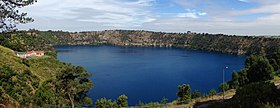|
Blue Lake / Warwar
Blue Lake / Warwar (The Blue Lake) is a large, monomictic, crater lake located in a dormant volcanic maar associated with the Mount Gambier maar complex. The lake is situated near Mount Gambier in the Limestone Coast region of South Australia, and is one of four volcanic crater lakes originally on Mount Gambier maar. Of the four lakes, only two remain, the other one being Valley Lake / Ketla Malpi; the other two, Leg of Mutton Lake / Yatton Loo and Brownes Lake / Kroweratwari, dried up as the water table dropped. HistoryConflicting dates have been estimated for the last eruption of the volcano: of 4,300 years ago,[1] of 28,000 years ago,[2] and a little before 6,000 years ago.[2][3] If the youngest date is correct, this could be the most recent volcanic eruption on the Australian mainland.[citation needed] The Boandik (or Bungandidj) people occupied the area before the colonisation of South Australia.[4][5] DescriptionBlue Lake / Warwar is one of four lakes in the Dormant volcano complex. Sites of cultural significance to the Boandik people were assigned dual names by the City of Mount Gambier in February 2022, and the renaming included the four lakes in the Bungandidj language. These are as follows:[4][5]
Blue Lake is thought to be of an average depth of 72 m (236 ft), but in places reaches 75 m (246 ft) deep (but some unconfirmed values mention a 204 m (669 ft) maximum depth due to a natural cave section). The crater rim measures 1,200 by 824 m (3,937 by 2,703 ft), but the lake itself measures 1,087 by 657 m (3,566 by 2,156 ft). The surface of the lake is 17 m (56 ft) below the level of the main street of the nearby town. The Blue Lake supplies the town with drinking water.[citation needed] Browne's Lake / Kroweratwari (sometimes spelt Browns Lake) dried up in the 1980s, and is now a picnic spot.[6] There is a 3.6 km (2.2 mi) road and walking track around the circumference of Blue Lake / Warwar, with an underpass between it and Leg of Mutton Lake / Yatton Loo.[7] Annual colour change  Each November, the lake turns to a deep turquoise colour, gradually returning to a duller blue colour in late February to March.[7] The exact cause of this phenomenon is still a matter of conjecture, but likely it involves the warming of the surface layers of the lake during the summer to around 20 °C (68 °F), causing calcium carbonate to precipitate out of the solution and enabling microcrystallites of calcium carbonate to form. This results in scatter of the blue wavelengths of sunlight. During winter, the lake becomes well mixed, and recent research indicates that during this phase of the colour cycle, the lake is somewhat murkier due to the redistribution of tannins and calcium carbonate particles throughout the lake. Solar elevation has also been found to influence the perceived colour of the lake. The movement of planktonic life forms within the lake during the seasons and during the day may additionally play a part in the colour change.[citation needed] StudiesBathymetric surveys located the deepest point in the lake at 77 m (253 ft) in 1967.[8] Major diving exploration of the lake first occurred in 1985. Cave diver Peter Horne conducted temperature and visibility studies and made discoveries of a freshwater sponge species and other invertebrates.[8] This exploration also discovered the Stromatolite Field, a collection of hollow rock formations that are found along the north-eastern perimeter down to a depth of 40 m (130 ft).[8] In 2008, permission was granted by SA Water for another diving exploration of the central and deepest parts of the lake.[8] On this dive, core samples from the calcite-silt covered lake bed were collected where water temperature drops to 14 °C (57 °F).[citation needed] Gordon's leap In July 1865, Adam Lindsay Gordon performed the daring riding feat known as Gordon's Leap on the edge of the Blue Lake. A commemorative obelisk erected there has an inscription which reads:[9]
Gallery
See alsoWikimedia Commons has media related to Blue Lake, South Australia. References
Further reading
|
||||||||||||||||||||||||||||||||||||



